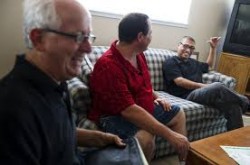Do I Have to Go to Sober Living After Rehab?
Sober living environments are facilities used by addicts recovering from substance abuse, which serve as an interim environment between rehab and a return to their former lives. Sober living facilities allow people who don’t have stable living arrangements to have a place to live while they are receiving outpatient treatment.
It also provides them with a safe, conducive place to live after they complete outpatient treatment, until they are able to move out on their own and feel comfortable living independently. While it is not required, it greatly increases a person’s chances of long term recovery.
Often patients are released back to their homes immediately after treatment. This places them right back in the destructive environment they were trying to escape in the first place. Because there are particular stresses that will trigger a person to use drugs or alcohol they must be careful to isolate themselves from people who trigger those stressors.

While you are not required to go, sober housing is a great help.
They are often tempted to resume relationships with people in their lives that are a negative influence and have not yet built up the defenses to keep from relapsing back into drug or alcohol use. Most of the time, they can’t go back with their families. Even if there aren’t drugs in the home, they will find themselves returning to an enabling relationship and then don’t make progress.
Many sober livings are also intensive outpatient treatment centers and provide a degree of medical care on-site. Often these homes are staffed in shifts by psychiatric nurses and licensed clinical social workers so that the residents can have 24hr supervision and centralized recovery care.
What Are The Requirements While In a Sober Living Facility?
Sober living facilities help recovering addicts relearn basic living skills while in a drug free environment. They promote consistency and stability by requiring the resident to adhere to strict rules. No Drugs or Alcohol is permitted at the facility. The residents are required to wake up and go to bed at certain times. They must help prepare and clean up after meals. They are often required to pay rent and attend house meetings regularly Everything including chores are done on a schedule and usually done as a team effort. Counselors are often on hand and residents receive transportation to Alcoholics Anonymous or Narcotics Anonymous meetings. Residents are usually allowed to stay in the house as long as they pay rent and other costs and they obey house rules.
According to the NCBI at www.ncbi.nlm.nih.gov Developing a social network that supports ongoing sobriety is also an important component of the recovery model used in Sober Living Facilities. Residents are encouraged provide mutual support and encouragement for recovery with fellow peers in the house. Those who have been in the house the longest and who have more time in recovery are especially encouraged to provide support to new residents. This type of “giving back” is consistent with a principle of recovery in 12-step groups. Residents are also encouraged to avoid friends and family who might encourage them to use alcohol and drugs.
 What is a Sunday Night House Meeting? -
These meetings help to strengthen the bond between residents and creates a sense of community in the house.
What is a Sunday Night House Meeting? -
These meetings help to strengthen the bond between residents and creates a sense of community in the house.  How to Choose a Sober Living Home -
Sober housing is a smart idea for making a smooth transition after rehab. Choosing a home requires considerations about location, cost, and more.
How to Choose a Sober Living Home -
Sober housing is a smart idea for making a smooth transition after rehab. Choosing a home requires considerations about location, cost, and more.  10 Tips for Getting Along with Others in a Sober House -
Remembering that your fellow residents are in the same situation as you can help you keep an open mind and be more accepting of others.
10 Tips for Getting Along with Others in a Sober House -
Remembering that your fellow residents are in the same situation as you can help you keep an open mind and be more accepting of others.  Myths about Driving Under the Influence of Marijuana -
Many people believe that driving under the influence of marijuana is less dangerous than driving drunk.
Myths about Driving Under the Influence of Marijuana -
Many people believe that driving under the influence of marijuana is less dangerous than driving drunk.  20 Reasons to Choose a Sober House -
Living in a sober house is a safe way to gradually transition from treatment back into society.
20 Reasons to Choose a Sober House -
Living in a sober house is a safe way to gradually transition from treatment back into society.